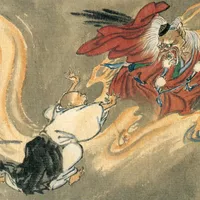なまはげ
Folklore-Dämonen der Oga-Halbinsel (Dorfbewohner verkleiden sich als Namahage usw.)
folklore demons of the Oga Peninsula (villagers dress up as namahage on New Year's Eve and frighten children)
folkloristische demonen van het schiereiland Oga (dorpelingen verkleden zich als namahage, enz.)
demónios do folclore da Península de Oga (os habitantes vestem-se de namahage, etc.)
生剝鬼
秋田 県 男鹿 (おが)半島 に は 、「なまはげ」 と いう お祭り が あります 。
あきた|けん|おとこ しか|おが|はんとう||||||おまつり||
||Oga|Oga|||||||||
Auf der Oga-Halbinsel in der Präfektur Akita findet ein Festival namens "Namahage" statt.
There is a festival called "Namahage" on the Oga Peninsula in Akita Prefecture.
この お祭り は 、 大みそか に 行われます 。
|おまつり||おおみそか||おこなわ れます
|||New Year's Eve||will be held
This festival is held in New Year's Eve.
藁 で できた 蓑 を 来て 、 鬼 の ような 怖い 顔 の お面 を かぶって 包丁 を もった 男 の 人 が 村 の 家々 を 訪ね 歩き 、「 泣く 子 は いねがぁ 。
わら|||みの||きて|おに|||こわい|かお||お おもて|||ほうちょう|||おとこ||じん||むら||いえいえ||たずね|あるき|なく|こ||いね が ぁ
straw||||||||||||||||||||||||||visited|||||いない
A man wearing a straw straw straw hat, a mask with a scary ogre-like face, and a knife walked from house to house in the village, saying, "There will be no crying children.
わりぃご は いねがぁ ( 泣く 子 は いない か 。
わり ぃご||いね が ぁ|なく|こ|||
sorry||いねがぁ|||||
No one is crying.
悪い 子 は いない か 。」
わるい|こ|||
Are there any bad kids?
と 、 声 を 掛けます 。
|こえ||かけます
|||will call
I will call out to them, "I'm sorry, I'm sorry.
もちろん 、 小さな 子供 たち は 、 大 泣き してしまいます 。
|ちいさな|こども|||だい|なき|して しまいます
|||||||will end up
Of course, small children cry a lot.
小さな 子供 に とって は 、 とても 刺激 が 強い お祭り です が 、 昔 から 幼児 の しつけ の ため に 行われてきた 伝統 が あります 。
ちいさな|こども|||||しげき||つよい|おまつり|||むかし||ようじ||||||おこなわれて きた|でんとう||
||||||stimulation||||||||toddler||discipline||||has been held|tradition||
This is a very stimulating festival for young children, but it has a long tradition of being held for the purpose of disciplining young children.
ちなみに 、 この 祭り は 、 国 の 重要 無形 文化財 に 指定 されています 。
||まつり||くに||じゅうよう|むけい|ぶんか ざい||してい|されて います
by the way||festival|||||cultural|cultural property||designated|
Incidentally, this festival is designated as an important intangible cultural property of Japan.
なまはげ 。
見かけ は 、 鬼 の ような 恐ろしい 姿 です が 、 実は 、「 神様 の 使い 」 と 言われています 。
みかけ||おに|||おそろしい|すがた|||じつは|かみさま||つかい||いわれて います
appearance||||||||||||||
Although they look scary like demons, they are actually said to be "messengers of God.
新年 を 迎える 前 に 、 災い を 払ったり 、 子供 や お嫁 に きた 女性 を 祝福 する と いう 意味 が ある そうです 。
しんねん||むかえる|ぜん||わざわい||はらったり|こども||お よめ|||じょせい||しゅくふく||||いみ|||そう です
New Year||to welcome|||disaster||driving away||||||||blessing|||||||
It is said to ward off bad luck before the New Year and to bless children and brides-to-be.
最近 は 、 観光 客 向け に イベント に なっている ので 、 日本 に 旅行 する 際 、 見 に 行って みる の も 面白い でしょう 。
日本 の 鬼 。
さいきん||かんこう|きゃく|むけ||いべんと||なって いる||にっぽん||りょこう||さい|み||おこなって||||おもしろい||にっぽん||おに
||sightseeing||for||event||becoming|||||||||||||||||
It has recently become a tourist event, so it would be interesting to see it during your trip to Japan.
ただ の 不気味で 恐ろしい 怪物 で は なく 、 人々 を 戒めたり 、 祝福 を も たらす 存在 でも あり 、 一言 で は 説明 できない もの です 。
||ぶきみで|おそろしい|かいぶつ||||ひとびと||いましめたり|しゅくふく||||そんざい|||いちげん|||せつめい|でき ない||
||eerie||||||||admonish||||to bring||||a word||||||
It is not just an eerie and terrifying monster, but also a reminder and a blessing, something that cannot be described in a single word.
鬼 は 、 日本語 の ことわざ や 表現 に も たくさん 出てきます 。
おに||にっぽん ご||||ひょうげん||||でて きます
||||proverb||expression||||
Oni" can be found in many Japanese proverbs and expressions.
あなた も 、 日本語 の 勉強 の 中 で 見つけて くださ い 。
||にっぽん ご||べんきょう||なか||みつけて||
Please find it in your Japanese studies.

